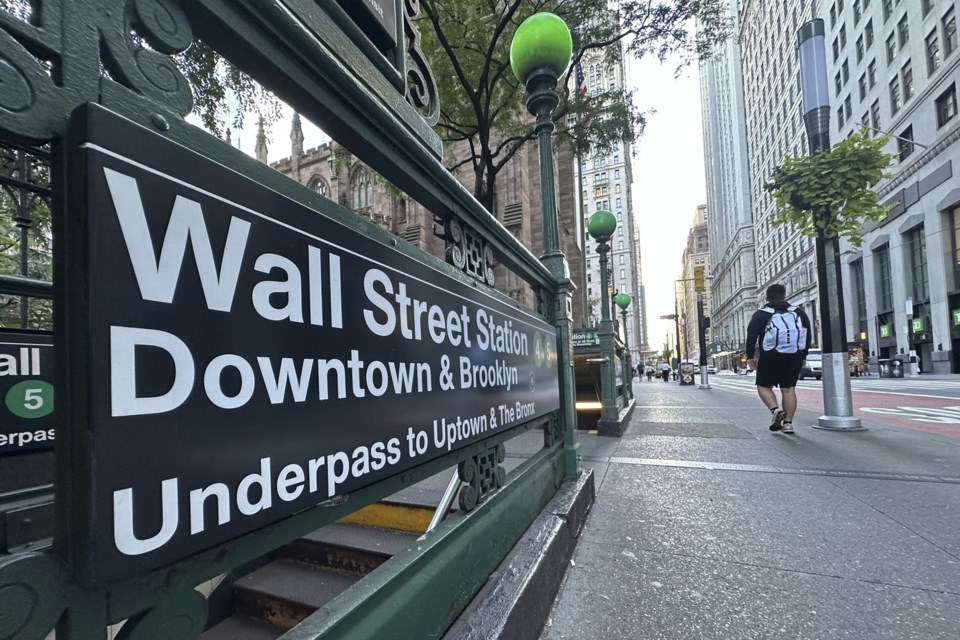NEW YORK (AP) — U.S. stocks tumbled Tuesday to their worst day since an early August sell-off, as a week full of updates on the economy got off to a discouragingly weak start.
The S&P 500 sank 2.1% to give back a chunk of the gains from a three-week winning streak that had carried it to the cusp of its all-time high. The Dow Jones Industrial Average dropped 626 points, or 1.5%, from its own record set on Friday before Monday’s Labor Day holiday. The Nasdaq composite fell 3.3% as Nvidia and other Big Tech stocks led the way lower.
Treasury yields also stumbled in the bond market after a report showed U.S. manufacturing shrank again in August, sputtering under the weight of high interest rates. Manufacturing has been contracting for most of the past two years, and its performance for August was worse than economists expected.
“Demand remains subdued, as companies show an unwillingness to invest in capital and inventory due to current federal monetary policy and election uncertainty,” said Timothy Fiore, chair of the Institute for Supply Management’s manufacturing business survey committee.
Stocks of oil and gas companies were some of the market’s biggest losers after the price of crude oil fell roughly 4% on concerns about how much fuel a fragile global economy will burn. A barrel of benchmark U.S. oil is almost back to $70 and down for the year after climbing above $85 in April.
Exxon Mobil lost 2.1%, and ConocoPhillips dropped 3.5%.
Similar worries about a slowing U.S. economy and a possible recession had helped send stocks on a scary summertime swoon in early August. It briefly knocked the S&P 500 nearly 10% below its record set in July, but financial markets quickly rebounded on hopes that the Federal Reserve could pull off a perfect landing for the economy.
The Fed appears set to lower interest rates later this month in hopes of easing conditions for the economy and avoiding a recession after earlier jacking its main interest rate to a two-decade high to beat high inflation.
Other reports due later this week could show how much help the economy needs, including updates on the number of job openings U.S. employers were advertising at the end of July and how strong U.S. services businesses grew last month. The week’s highlight will likely arrive on Friday, when a report will show how many jobs U.S. employers created during August.
The jobs report has once again become the main event for the stock market each month, taking over from updates on inflation, according to analysts at Bank of America. Many traders are anticipating the Fed will deliver a full percentage point of cuts to interest rates this year, which is a “recession-sized” amount, Gonzalo Asis and other economists and strategists wrote in a BofA Global Research report.
The strength of this jobs report, or lack thereof, will likely determine the size of the Fed’s upcoming cut, according to Goldman Sachs economist David Mericle. If Friday’s data shows an improvement in hiring over July’s disappointing report, it could keep the Fed on course for a traditional-sized move of a quarter of a percentage point.
But if Friday’s report is weaker, it could drive the Fed to deliver an outsized cut of half a percentage point from the federal funds rate’s current range of 5.25% to 5.50%, Mericle said.
While cuts to rates are generally boons to investment prices, a recession could more than wipe out that benefit by dragging down corporate profits.
On Wall Street, U.S. Steel fell 6.1% in its first trading after Vice President Kamala Harris said Monday that she opposed the company’s planned sale to Japan’s Nippon Steel. The Democratic presidential nominee’s comments, which echo President Joe Biden’s position, came after Nippon Steel Corp. said last week it would spend an additional $1.3 billion to upgrade facilities in Pennsylvania and Indiana, on top of a previous $1.4 billion commitment.
Nippon Steel also reiterated that it expects the transaction to close by the end of this year, despite ongoing political and labor opposition.
Nvidia was the heaviest weight by far on the S&P 500 after falling 9.5%. Its stock has been struggling even after the chip company topped high expectations for its latest profit report. The subdued performance could bolster criticism that Nvidia and other Big Tech stocks simply soared too high in Wall Street’s frenzy around artificial-intelligence technology.
All of the stocks that have come to be known as the “Magnificent Seven,” which accounted for the vast majority of the S&P 500’s return last year and early this year, fell at least 1.3%.
Still, it wasn’t a complete washout on Wall Street. Nearly 30% of the stocks within the S&P 500 climbed, led by those that tend to benefit the most from lower interest rates. That includes dividend-paying stocks, as well as companies whose profits are less closely tied to the ebbs and flows of the economy, such as real-estate stocks and makers of everyday staples for consumers.
All told, the S&P 500 fell 119.47 points to 5,528.93. The Dow dropped 626.15 to 40,936.93, and the Nasdaq composite sank 577.33 to 17,136.30.
In the bond market, the yield on the 10-year Treasury fell to 3.84% from 3.91% late Friday. That’s down from 4.70% in late April, a significant move for the bond market.
In stock markets abroad, indexes were lower across much of Europe and Asia.
Worries were also growing about the resilience of China’s economy, as recently disclosed data showed a mixed picture. Weak earnings reports from Chinese companies, including property developer and investor New World Development Co., added to the pessimism.
___
AP Business Writers Yuri Kageyama and Matt Ott contributed.
Stan Choe, The Associated Press



